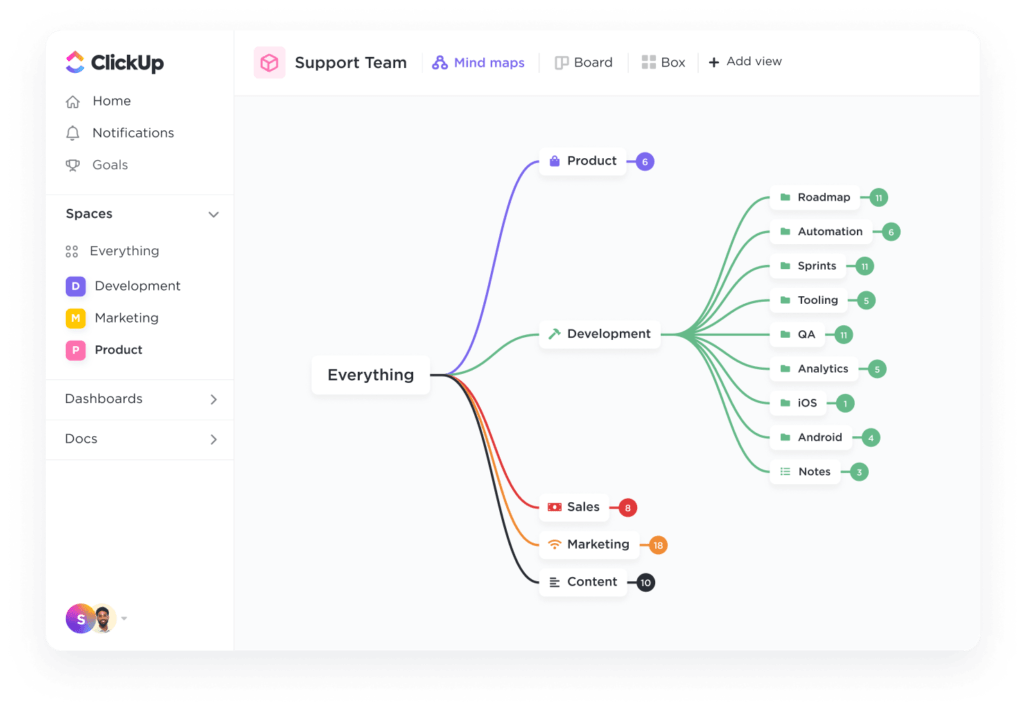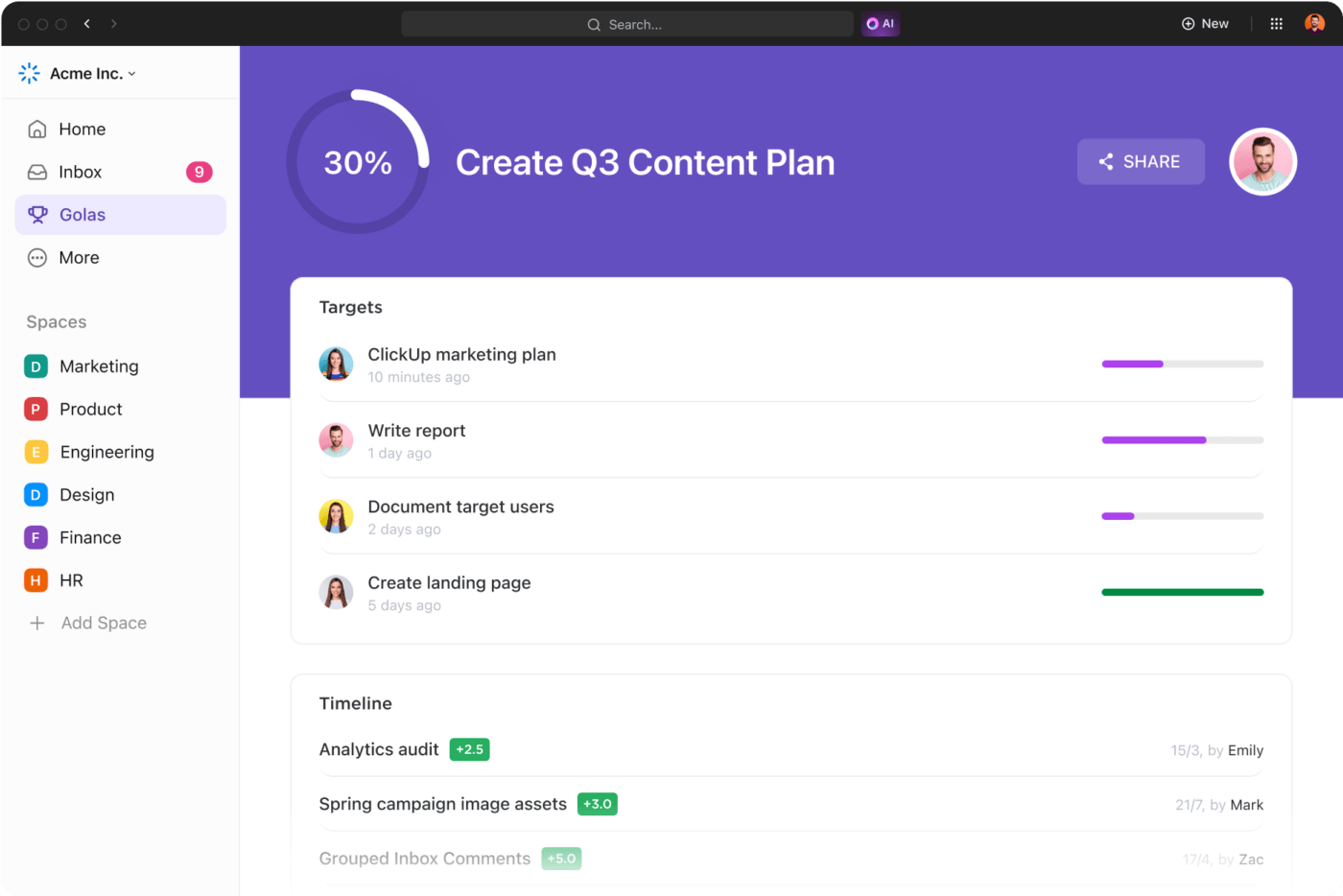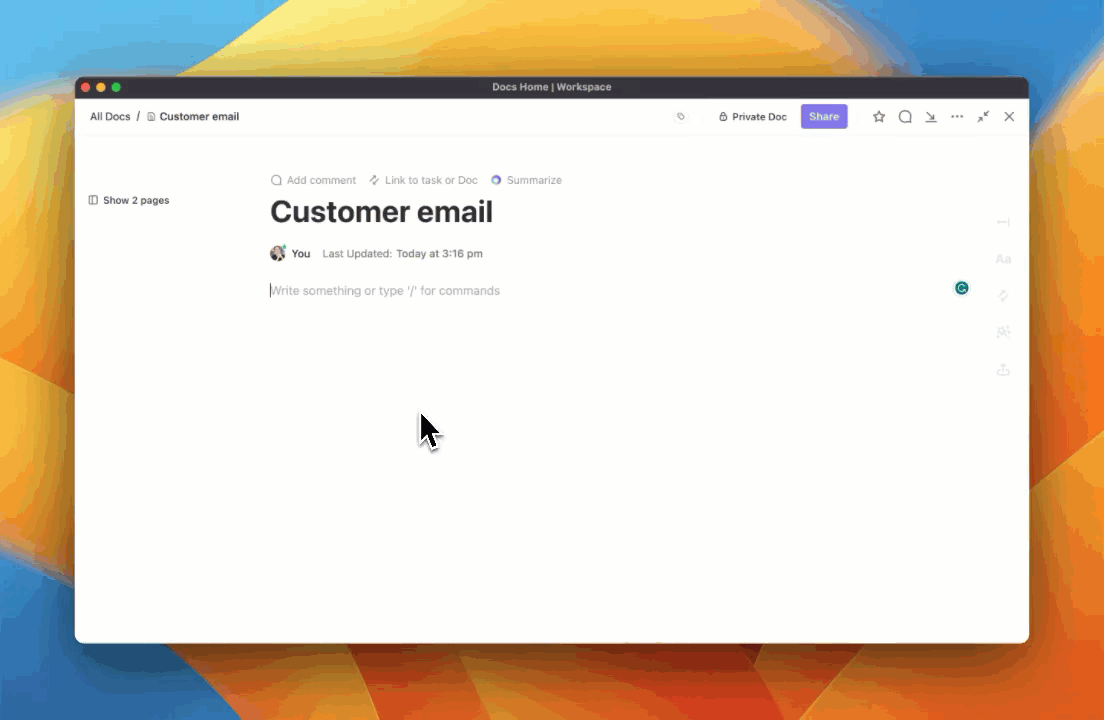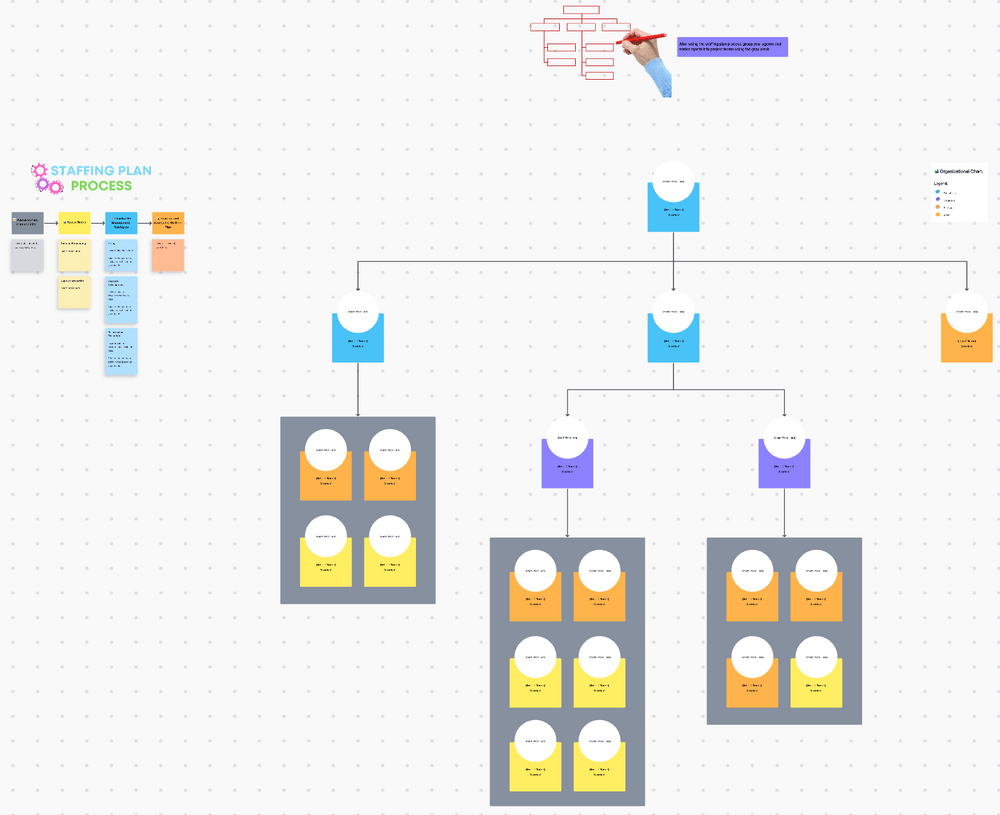

Every employee’s North Star is giving their best at work. However, only 41% of employees today feel they are performing optimally.
Closing this performance-skills gap and unlocking employee growth is the organization’s responsibility. An effective way to do this is by mapping the team’s journey using an employee journey map. When done right, it boosts employee retention, increases employee engagement, and improves overall experience.
In this guide, we’ll explore employee journey mapping, including its definition, how it benefits your organization, and how to create one in six simple steps.
- What is Employee Journey Mapping?
- Benefits of Employee Experience Journey Mapping for Employees and Managers
- 5 Employee Journey Stages to Know
- 6 Steps to Create an Employee Journey Map
- What to Include in an Employee Journey Map
- What to Avoid in an Employee Journey Map?
- Three-fold Impact of Good Employee Journey Mapping
- Build a Positive Employee Journey From Day Zero with ClickUp
- Frequently Asked Questions (FAQ)
What is Employee Journey Mapping?
Employee journey includes everything a person does, feels, and internalizes from when they see your job description on a job portal to when they exit your organization.
This framework—an HR favorite—enables managers to assess all facets of an employee’s experiences during their tenure with the organization.
Employee journey mapping allows you to visualize each employee’s experience at your company, from recruitment to when they leave. The goal is to:
- Identify areas of improvement within the current employee experience
- Create opportunities for adding value to the employee’s work and build a positive employee experience
- Gather real-time feedback from employees on what’s working for them and what isn’t
- Assess employee satisfaction level and take corrective action to improve it
- Pen more accurate and relevant job descriptions
- Inform your budget and allocate it to areas that increase employee engagement
Benefits of Employee Experience Journey Mapping for Employees and Managers
Motivated, engaged employees drive success for your organization. However, you can’t succeed at creating value for employees if you don’t know how you’re doing currently or what they find essential. Enter employee journey maps.
Using employee experience journey mapping poses multiple benefits for both employees and managers.
How employee experience mapping helps employees
Insights derived from an employee journey map help organizations find ways to boost employee satisfaction.
As the company takes action to address the gaps in the employee experience, the employees will start feeling happier at their jobs.
They’ll be more motivated to deliver high-quality work.
How employee experience mapping assists managers
An employee journey map is a gateway into how your employees are performing and what’s standing in their way to success. Think of it as a sum of your employee experiences expressed in a highly visual and easy-to-understand manner.
A visual map, like an employee journey map, allows stakeholders and leadership to understand the employee’s experience with the organization much better. It lets them know what is working in their present employee experience and what isn’t.
Managers leverage employee journey mapping to improve every employee’s experience within the company and gain a competitive talent edge.
When employees voluntarily choose to stay on, managers can use their time to build a talent pipeline of high-performing talent instead of dealing with high employee turnover rates. It also helps them prioritize resources, budget, etc., and clarify employee roles.
Moreover, with insights from the employee journey map, leaders and managers can find ways to design jobs and benefits to attract high-quality talent and have a ready pool of interested candidates for their hiring needs.
5 Employee Journey Stages to Know
Each employee experiences a series of stages—from the moment they apply for a job until they leave. This journey runs through five stages of the employee lifecycle:
Stage 1: Recruitment
The recruitment stage includes all the steps that come with hiring an employee, including important considerations such as:
- How long does it take, and how much does it cost to hire a prospective candidate
- The job offer acceptance rate
- The quality of new hires
- The attractiveness of company job postings
- Candidate engagement levels during the interview process.
Recruiting teams often use HR templates to improve this stage of the hiring process.
For instance, ClickUp’s Staffing Plan template allows your HR team to create a comprehensive staffing plan that:
- Visualizes the availability of each team member
- Facilitates task assignments based on availability
- Provides a comprehensive overview of all team members and their skillsets
Hiring managers can use the plan as the backbone to hire employees according to skills, expertise, and available funds.
Stage 2: Onboarding
The onboarding stage refers to the first few weeks on the job when new hires familiarize themselves with the company’s processes and people.
HR teams usually create employee handbooks to help new hires onboard faster and clarify their roles and responsibilities. This can also be done with the help of onboarding software.
A well-designed and implemented employee onboarding process helps employees become more productive in their roles and build long-term connections with the organization.
Stage 3: Development
The development stage focuses on helping employees develop their skills and expertise at different rates.
It entails reviewing employee performance to measure productivity and outcomes, assess soft skills like teamwork, and understand career aspirations. This helps managers offer opportunities for expanding their skill sets. It also creates opportunities for incremental advancements such as role transitions, promotions, etc.
HR teams can use a variety of talent management software to drive initiatives. Some companies also help employees upskill or improve job performance through training programs using specialized training software.
Stage 4: Retention
The retention stage entails maintaining an employee’s performance, fostering their development, and encouraging their continued contribution to the company’s success.
At this stage, the company must ensure employees feel connected to its mission and are motivated to give their best.
Organizations deploy strategies to retain talent, such as:
- Inclusive parental leave policies
- Options for extended leave and sabbaticals
- Rewards and recognition programs
- ESOPs and cash incentives for top performers
- Opportunity for remote or hybrid work
- Celebrating work anniversaries, birthdays, etc.
Stage 5: Exit
The exit stage refers to employees leaving the company (either due to retirement, life changes, etc., or opportunities in other organizations). Here, the HR team conducts exit interviews to understand what went wrong with the employee’s experience and to make improvements.
6 Steps to Create an Employee Journey Map
Listening to your employees at each stage of their journey within the organization forms the basis of a robust employee experience journey map. But where do you even start?
Let’s walk through the steps to create an employee journey map to help you understand your employees’ personalized needs.
Use this 6-step checklist to create a comprehensive map highlighting significant milestones, pivotal moments, and factors that matter to your employees.
Step 1: Define your employee persona
The first step in employee experience journey mapping is segmenting your employees and creating an employee persona. Refrain from basing your employee persona on details such as demographics. Instead, segment employees based on job roles (such as individual contributor, team leader, etc.), groups (such as remote or on-site employees, new employees or experienced managers, etc.), functions (such as finance, marketing, etc.), and levels.
For example, an entry-level designer’s employee experience journey map will differ from that of a mid-level marketing manager.
Once you’ve defined your employee personas, prioritize which personas to map first.
Pro tip: When creating the employee persona, make sure to include your employee advocates and past employees who may have rejoined your company to get a more holistic understanding of what your employees want and where your organization missed the mark.
Step 2: Identify touchpoints
Next, you must document the interactions throughout the employee’s time within your organization—from recruitment to departure. Get input from cross-functional teams and departments for more well-rounded feedback.
To identify the right touchpoints, view your persona’s experience across five key stages and the activities and interventions you have in place for the respective stage:
- Recruitment: Job listings, interview processes, contract discussions and finalization
- Onboarding: Interactions from day one to the employee being fully integrated within the organization
- Development: Performance evaluations, opportunities to build skills, training interventions, growth opportunities
- Retention: Elements of the job that help engage and keep employees happy, e.g., benefits, leave policy, job satisfaction, recognition, etc.
- Exit: Exit interviews when employees resign, the offboarding process
Alternatively, if your organization has a set role progression system, use time as the marker for plotting your persona’s experience. Use this example and tweak as you see fit:
- Day zero (before the first day)
- Day one
- 30 days in
- 60 days in
- 90 days in
- One-year mark
- Two-years mark
- Offboarding
Step 3: Understand employee needs
The third step requires you to map employee feedback and the impact of each interaction on every stage of the employee lifecycle.
To do this, include all possible factors impacting your employee experience. List processes under each stage to ensure you cover all key employee experiences.
For instance, let’s assume your employee is in the recruitment stage. Critical processes to review and map the employee experience include:
- Posting the job opening on relevant platforms like LinkedIn, Glassdoor, etc.
- Reaching out to candidates with personalized emails or messages
- Coordinating interviews with the hiring team
- Conducting interviews with a customized questionnaire
- Communicating with candidates about the status of their application
- Hosting virtual or in-person networking events for potential candidates
- Providing resources and how-to guides about the company culture and values
- Offering insights into the team structure and potential career paths within the organization
You can map the employee journey in various formats, such as a list or a timeline.
When brainstorming with employees to understand their professional goals at work, use a custom, ready-to-use template like ClickUp’s Career Path Template.
This template is ideal for:
- Creating career pathways that integrate personal career aspirations and organizational objectives
- Demonstrating opportunities for employee engagement, growth, and learning
- Tracking each employee’s progress towards professional goals for powerful team management
- Planning and setting S.M.A.R.T milestones for each team member
Pro tip: Use career map templates to identify career growth opportunities and support your employees with a milestone-driven roadmap.
Step 4: Map out the current employee experience
Plotting the employee experience includes integrating all key moments that matter to your employees. This is where an empathy map template helps understand your employees’ thinking.
You must make the employee journey map as in-depth as possible, including critical resources employees need and all processes employees must complete at every stage.
Given there are so many moving parts to consider, you need a highly visual tool like ClickUp’s Mind Maps to visualize the employee journey map easily:

Collaborate with employees to map the journey and update the content with the tool’s drag-and-drop nodes. Build task-based or node-based mind maps depending on the type of employee journey you want to map out.
Step 5: Identify gaps with real-time employee feedback
The best way to identify gaps and value-creation opportunities within your current employee experience is to get in-the-moment information about your employee’s goals.
You need to know your employees’ professional aspirations to ensure your employee experience is smooth and relevant.
Charting out employee goals is extremely easy with ClickUp Goals:

Use this feature to set trackable goals along the employee journey. Whether you establish OKRs, weekly employee scorecards, etc., all your objectives can be defined with clear timelines and measurable targets. Plus, managers get to save time with an automated progress-tracking process in place.
Once you’ve outlined the goals, it’s time to set up a mechanism for gathering stage-based or time-based employee feedback. Meet employees where they are and get honest, fresh feedback on their employee journey.
Use the following questions to uncover a pattern within each stage:
- Which stages have positive or negative feedback?
- Are there common sentiments across stages? Can they be addressed promptly?
- Are you asking for feedback instantly instead of waiting for the right time?
For instance, if an employee complains of incorrect job descriptions compared to their daily responsibilities, you can change the job descriptions at the hiring stage.
Here’s a checklist of tools to use and collect employee feedback most effectively:
- Anonymous surveys for onboarding
- NPS surveys with open-text follow-up questions
- One-on-one private interviews
- Annual employee engagement surveys
- Exit interviews
- Online reviews from current or past employees on websites such as Indeed, Glassdoor, etc.
- Virtual suggestion boxes
Step 6: Implement changes and measure success
Based on the feedback gained, it’s time to put the feedback into action. Where and how do you even begin?
Once you understand the feedback and how it impacts the employee experience, you’ll need to prioritize which feedback to act on first. You’ll also need to consider the budget and resource requirements for these changes.
After executing the changes, revise your employee journeys and assess them periodically to ensure they align with your employee’s current demands. Measuring the success of your employee journeys is as important as creating them.
Use ClickUp Brain to fast-track your information-gathering process. It has three AI-driven tools to help you manage your employee-related information, automate tasks, get answers to employee-centric questions, and create personalized content for your team—with an AI assistant as a sidekick.

Here’s a walkthrough of the three AI tools at your disposal:
- AI Knowledge Manager: Gets you instant, accurate, and contextual answers for any information related to your employees captured within ClickUp, such as what their current roles are, what projects they’re involved in, etc.
- AI Project Manager: Allows you to automate tasks, progress updates, and status reports for your employees so you won’t have to waste time on manual work such as creating performance reports for your employees, analyzing data on task completion rates, and so on
- AI Writer for Work: Doubles up as a writing assistant to help you perfect your documents, writing style, tone, and replies; the tool also lets you create tables, transcripts, and templates for your employees. Some common applications include checking for grammatical and spelling errors within project briefs, creating emails for internal communication, etc.

Take the help of AI and implement changes smarter and more efficiently.
What to Include in an Employee Journey Map
An effective employee journey map has its share of must-haves and benchmarks to follow. Use these tips to improve the quality of your journey mapping:
Gather and analyze employee feedback
Incorporate employee feedback using ClickUp’s Employee Feedback template to make your employee experience more inclusive and equitable while closing the employee expectations gap.
Leverage this template to understand what your employees think about the company, its corporate culture, management, etc. It also helps you gather meaningful employee feedback and track their sentiments over time.
The idea is to assess your employee’s current state of mind and evaluate their emotional state at every step of the way—a task for an all-in-one tool like the ClickUp HR management platform:

Leverage this software to gather qualitative and quantitative feedback and create the best onboarding experience. The tool offers customizable views to align the team and build a central hub for important employee information.
Use agile software to improve employee journey mapping
Capturing employee feedback at the right time is key. And expecting the team to do this manually is a waste of valuable resources and time. This is where leveraging agile software like ClickUp to implement agile methodologies pays off. You’ll be able to:
- Gather feedback from employees at various touchpoints in real time and get up-to-date insights into their experiences when they happen
- Track changes and improvements made based on employee feedback and ensure your employee’s concerns are addressed quickly
- Combine different feedbacks across teams, departments, and roles to promote a shared understanding of what’s working well and drive team collaboration
- Iterate and adapt your employee journey mapping process and ensure it remains relevant and effective
- Involve employees within the employee journey mapping process and enhance their engagement levels
Pro tip: Integrate your employee experience program within your HR software and create triggers to send feedback requests when an employee completes certain tasks, achieves specific milestones, and more.
Analyze each stage from multiple viewpoints
Each phase of the employee journey is unique, necessitating a thorough examination of its various components.
For instance, viewing a stage solely from an employee’s perspective might overlook crucial factors related to prevailing business challenges.
Consider this scenario: Say you’re analyzing the “development” stage of the employee journey. While focusing solely on the employee’s experience, you might identify a need for more training opportunities.
However, if you consider additional factors, such as recent changes in technology and industry standards, you might realize the lack of training resources is due to budget constraints and outdated training materials—a more insightful and broader perspective to work with for your team.
Evaluate your end goals and be mindful of the people you involve
Including a mix of relevant roles in the assessment helps you clearly define your employee journey map. Examples include the HR team, L&D representative, cross-functional employee representatives, corporate communications team, and front-line managers.
Doing so will help you to understand:
- What your ideal journey mapping looks like
- How your employee journey will impact organizational tools and systems
- The issues you are trying to solve
- How to measure success and align it with organizational end goals
What to Avoid in an Employee Journey Map?
Let’s now look at what to avoid in an employee journey map.
Don’t go for a one-size-fits-all approach
No two employees are alike, and neither is their employee journey with the organization. Every employee brings unique experiences, skills, and aspirations to the table. If you don’t customize the employee journey to fit their individual needs and goals, you’ll not be able to drive higher engagement, satisfaction, and productivity.
Use tools like mind maps, sticky notes, or ClickUp Whiteboards to create a custom employee journey map that works:

ClickUp Whiteboards allows you to convert your team’s ideas into coordinated actions from a centralized place.
Having a template is great, but don’t be afraid to make it your own and build a personalized employee journey map for various employee personas.
Don’t forget to keep revising your employee journey map over time
Sure, every employee journey map looks different for different segments. However, it is an ever-evolving entity bound to change as your organization grows and your employee’s needs evolve. Constantly revisit your map and make changes that reflect the current reality.
Creating the employee journey map: a recap
- Define your employee persona(s)
- Identify all the touchpoints to measure
- Understand employee needs at every stage
- Map the current employee experience from various viewpoints
- Use internal feedback to identify gaps in the experience
- Personalize and improve the employee journey and reassess it at intervals
- Keep the end goal in mind
Three-fold Impact of Good Employee Journey Mapping
Employee journey mapping impacts the organization in three interconnected ways:
Builds an employee-centric workplace culture
Considering you’re gathering employee feedback and taking informed actions, you’ll understand the moments that matter the most and how they affect the employee experience.
With strategic insights and data on key metrics such as attrition, engagement, and productivity, your work culture and thinking process become more employee-centric.
Improves customer satisfaction rates
As your employees serve with a new-found sense of purpose, your customers will be happier with a higher quality of service. As customer satisfaction rates soar, more customers will likely become loyal to your brand and be long-term brand advocates.
Increases motivation in the workforce
Employee journey mapping reveals hidden aspects of your employee experience. These unseen experiences double up as an opportunity to meet—and exceed—employee needs. As the employee experience improves, your employees will be happier and more motivated.
Build a Positive Employee Journey From Day Zero with ClickUp
Optimizing your employee experience starts with mapping each individual employee’s journey and listening to your employees at every stage. Using agile software like ClickUp helps understand your employee’s emotional, mental, and career goals. You’ll be able to connect with employees at critical moments and get their feedback on what sticks for them and what isn’t working.
The insights you extract from employee journey mapping will help you improve—and master—the employee experience. With timely action, your organization can cement a solid place in employees’ minds and gain their loyalty in the long run.
Make the most of this impactful visualization technique with ClickUp and build a meaningful employee journey map filled with all the moments that matter. Sign up now!
Frequently Asked Questions (FAQ)
1. How do you draw an experience map?
To draw an employee experience map, follow these steps:
- Step 1: Learn about your employee goals and needs. Use this information to build your employee persona
- Step 2: Identify personas to prioritize as well as touchpoints within the employee experiences across five stages: recruitment, onboarding, development, retention, and exit
- Step 3: Map the employee journeys for each persona
- Step 4: Collect employee feedback
- Step 5: Identify opportunities for improvement and create value
- Step 6: Execute changes and measure the employee journey map for success






